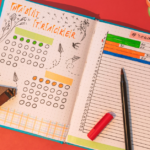Dreams offer fleeting glimpses into our subconscious, revealing our deepest fears, wants, and unresolved issues.
Dream journaling captures these elusive nocturnal narratives, harnessing the secrets of your subconscious mind, enhancing creativity, and even helping solve real-world problems.
Consistent recording and reflection on your dreams builds a bridge between your conscious and unconscious mind, leading to greater self-understanding and personal growth.
This practice goes beyond simply jotting down nightly adventures – it’s a powerful tool for self-discovery and transformation.
The Science Behind Dreams
Understanding the science of dreams provides valuable context for dream journaling. During sleep, our brains cycle through different stages, with the most vivid dreams occurring during Rapid Eye Movement (REM) sleep.
This stage is characterized by increased brain activity, similar to when we’re awake.
Dreams serve many purposes:
- Processing emotions
- Consolidating memories
- Problem-solving
- Enhancing creativity
Research has shown that dreams play a crucial role in emotional regulation, memory consolidation, and cognitive processing.
By tapping into this nightly phenomenon through dream journaling, we gain valuable insights into our psyche and harness the power of our subconscious mind.
Setting Up Your Dream Journal
Creating a dedicated space for recording your nocturnal adventures is the first step in your dream journaling practice.
Choose a method that resonates with you – whether it’s a physical notebook, a digital app, or even voice recordings. The key is accessibility, allowing you to capture your dreams immediately upon waking.
Place your chosen journal and a pen (if using a physical notebook) by your bedside. This proximity will remind you to record your dreams and make it convenient to do so before the memories fade.
Some people prefer using smartphones or tablets with dream journaling apps, which can offer extra features like tagging, searching, and even dream analysis tools.
If you opt for a physical journal, consider choosing one with high-quality paper that can withstand various writing tools, including colored pencils or markers. This allows you to incorporate visual elements into your dream records if desired.
Techniques for Enhancing Dream Recall
Remembering dreams is often the biggest challenge in dream journaling. Here are some effective techniques to enhance your dream recall:
Set an Intention
Before going to sleep, affirm to yourself that you will remember your dreams. This simple act can significantly improve your recall.
You might say something like, “I will remember my dreams clearly and easily when I wake up.”
Wake Up Gradually
Use a gentle alarm or natural light to wake up slowly. Abrupt awakenings can cause you to forget your dreams.
Consider using a sleep cycle app that wakes you during lighter sleep stages, making it easier to remember your dreams.
Stay Still
Upon waking, stay in the same position for a few moments. This can help you hold onto the dream memories.
Avoid immediately checking your phone or jumping out of bed, as these actions can quickly erase dream memories.
Write Immediately
Record your dreams as soon as you wake up, even if it’s just fragments or emotions. Keep your journal and pen within arm’s reach, or have your phone ready if you’re using a digital method.
Don’t worry about perfect sentences or finish narratives – jot down whatever you can remember, no matter how disjointed it may seem.
Practice Regularly
Consistent dream journaling will train your brain to remember dreams more easily over time. Make it a daily habit, even if you don’t remember much at first.
Your dream recall will likely improve with practice.
Improve Sleep Quality
Ensure you’re getting enough quality sleep by maintaining good sleep hygiene practices. This includes:
- Sticking to a consistent sleep schedule
- Creating a relaxing bedtime routine
- Avoiding screens before bed
- Keeping your bedroom cool, dark, and quiet
Use Dream Anchors
Place objects related to topics you want to dream about near your bed to potentially influence your dream content. For example, if you want to dream about a vacation, place a seashell or travel brochure on your nightstand.
Dream recall is a skill that can be developed with practice. Don’t get discouraged if you struggle to remember your dreams at first.
With consistent effort, you’ll likely see improvement over time.
The Art of Dream Journaling
When recording your dreams, include as much detail as possible. Note the setting, characters, emotions, and any symbols or recurring themes.
Don’t worry about making sense of it all initially – focus on capturing the experience.
Here’s a structure you can follow for each entry:
- Date and time of the dream (if known)
- Title for the dream (this can help with quick reference later)
- Detailed description of the dream
- Emotions felt during and after the dream
- Any real-life events or thoughts that might have influenced the dream
- Initial interpretations or insights
Remember, there’s no right or wrong way to journal your dreams. The key is to find a method that works for you and helps you connect with your subconscious mind.
Example Dream Journal Entry
Date: April 15, 2023
Time: Around 3:00 AM
Title: The Underwater Library
I found myself in a large underwater library. The bookshelves stretched as far as I could see, filled with glowing, waterproof books.
I could breathe underwater, and as I swam through the aisles, I noticed other people browsing the shelves.
They all wore shimmering, fish-scale clothing.
I felt a sense of awe and curiosity, mixed with a slight anxiety about finding a specific book I needed. As I searched, the water around me changed colors – from deep blue to purple to green.
Suddenly, a giant octopus appeared, wearing a librarian’s glasses. It pointed one of it’s tentacles towards a shelf near the ocean floor.
I swam down and found a book titled “The Secrets of the Universe.” As I opened it, I woke up.
Emotions: Wonder, curiosity, mild anxiety, excitement
Possible influences: I visited the local library yesterday and had a conversation about marine biology with a friend.
Initial thoughts: This dream might reflect my want for knowledge and understanding of the world around me. The underwater setting could symbolize exploring the depths of my subconscious.
Interpreting Your Dreams
Dream interpretation is a complex and personal process. While many dream dictionaries and guides are available, it’s important to remember that dream symbols can have different meanings for different people.
Your personal associations and life experiences play a crucial role in understanding your dreams.
When interpreting your dreams, consider the following:
Emotions
Pay attention to how you felt during the dream and upon waking. Emotions can provide valuable clues to the dream’s significance.
For example, a dream about flying might generally be interpreted as freedom, but if you felt terrified during the dream, it could show anxiety about a lack of control in your life.
Symbols
Look for recurring symbols or themes in your dreams. These may represent important aspects of your life or psyche.
Keep in mind that symbols can be highly personal.
A snake in your dream might represent fear or danger to one person, but wisdom or transformation to another.
Context
Consider what’s happening in your waking life. Dreams often reflect our current concerns and experiences.
If you’re going through a major life change, your dreams might incorporate elements of that transition.
Archetypes
Explore universal symbols and archetypes, but always relate them back to your personal experience. Carl Jung’s work on archetypes can be a helpful starting point, but remember that your personal associations are most important.
Intuition
Trust your gut feelings about what the dream might mean. Your subconscious often communicates through intuition.
If a particular interpretation feels right, even if it doesn’t make logical sense, it’s worth exploring further.
While it can be helpful to ask dream dictionaries or seek input from others, remember that you are the ultimate authority on your dreams. Trust your own interpretations and insights.
Advanced Dream Journaling Techniques
As you become more comfortable with basic dream journaling, you may want to explore advanced techniques to deepen your practice:
Lucid Dreaming
Use your dream journal to identify dream signs that can trigger lucidity within your dreams. By recognizing these signs, you can potentially gain control over your dream narrative.
Look for recurring elements or themes in your dreams and practice reality checks during your waking hours.
This can increase your chances of becoming lucid in your dreams.
Dream Incubation
Set an intention to dream about a specific topic or problem before sleep. This technique can be particularly useful for problem-solving or gaining insights into specific areas of your life.
Before bed, spend some time focusing on the issue you want to explore, and ask your subconscious to provide guidance through your dreams.
Thematic Analysis
Look for patterns and themes across many dreams to gain broader insights into your subconscious mind and personal growth journey.
You might notice recurring symbols, emotions, or situations that provide clues about your deeper psychological processes.
Artistic Expression
Incorporate drawings, paintings, or collages into your journal to capture visual elements of your dreams. This can be especially helpful for visual thinkers or those who struggle with verbal descriptions.
Don’t worry about artistic skill – the goal is to express the essence of your dream visually.
Dream Sharing
Discuss your dreams with trusted friends or join a dream group to gain new perspectives on your dream symbols and themes.
Hearing others’ interpretations can provide fresh insights and help you see your dreams from different angles.
Shadow Work
Use your dreams to explore and combine the hidden or repressed aspects of your personality, as described in Jungian psychology.
Pay attention to characters or elements in your dreams that you find disturbing or uncomfortable, as these may represent aspects of your shadow self.
Dream Yoga
Incorporate meditation and mindfulness practices into your dream work to deepen your awareness and spiritual growth.
This Tibetan Buddhist practice involves maintaining awareness during the dream state and can lead to profound insights and experiences.
Overcoming Common Challenges
Dream journaling, like any practice, comes with it’s challenges. Here are some common issues and how to address them:
Forgetting Dreams
Be patient and consistent. Dream recall often improves with practice.
If you’re struggling, try setting many alarms throughout the night to wake up during different sleep cycles.
This can increase your chances of remembering dreams from various stages of sleep.
Lack of Time
Keep your entries brief if necessary. Even short notes can be valuable.
Consider using voice recordings if writing feels too time-consuming.
You can always elaborate on the details later when you have more time.
Disturbing Dreams
Remember that nightmares often reflect unresolved issues. Journaling can help process these emotions.
If nightmares continue, consider seeking support from a therapist specializing in dream work.
They can help you explore the underlying causes and develop coping strategies.
Overanalysis
Don’t force interpretations. Sometimes, simply recording the dream is enough.
Allow insights to emerge naturally over time.
Trust that your subconscious will reveal meanings when you’re ready to understand them.
Inconsistency
Set a regular sleep schedule and make dream journaling part of your nightly routine. Consistency is key to developing a strong practice.
Try to go to bed and wake up at the same time each day, even on weekends, to regulate your sleep cycles.
Feeling Overwhelmed
Start small. Focus on recording just one dream per week if daily journaling feels daunting.
Gradually increase frequency as you become more comfortable with the process.
Remember that any amount of dream journaling is useful.
Difficulty Interpreting Symbols
Remember that personal associations are more important than universal meanings. Trust your intuition and consider how the symbol relates to your own life experiences.
Keep a personal symbol dictionary to track recurring symbols and their meanings in your dreams.
The Transformative Power of Dream Journaling
As you explore further into your dream journaling practice, you may notice profound changes in your waking life. Many practitioners report increased self-awareness, enhanced creativity, and improved problem-solving skills.
Dreams can offer solutions to challenges, inspire artistic endeavors, and provide emotional healing.
By consistently recording and reflecting on your dreams, you’re building a bridge between your conscious and unconscious mind. This connection can lead to greater self-understanding, personal growth, and a more integrated sense of self.
Integrating Dream Insights into Daily Life
The true power of dream journaling comes from applying those insights to your waking life. Here are some ways to combine your dream wisdom:
Identify Patterns
Look for recurring themes or emotions in your dreams and consider how they relate to your daily experiences. These patterns may highlight areas of your life that need attention or change.
For example, if you often dream about being unprepared for an exam, it might show feelings of insecurity or imposter syndrome in your waking life.
Set Intentions
Use dream insights to guide your personal growth goals and daily intentions. If a dream reveals a fear or desire, consider how you can address it in your waking life.
For instance, if you dream about flying, you might set an intention to take more risks or seek out new experiences that make you feel free.
Creative Inspiration
Allow dream imagery and narratives to inspire your creative projects or problem-solving approaches. Many artists, writers, and inventors have found inspiration in their dreams.
Keep a separate section in your journal for creative ideas sparked by your dreams.
Emotional Processing
Use dreams as a tool for understanding and working through complex emotions. Dreams can often reveal feelings we’ve suppressed or haven’t fully acknowledged.
Take time to reflect on the emotions you experience in your dreams and how they might relate to your waking life.
Mindfulness Practice
Let your dreams remind you to stay present and aware in your daily life. The vivid experiences in dreams can encourage a deeper appreciation for the richness of waking life.
Practice bringing the same level of attention and curiosity to your daily experiences that you bring to your dreams.
Personal Growth
Use dream insights to identify areas for personal development. If you often dream about being unprepared, for example, it might show a need to build confidence or improve organization skills.
Consider how you can work on these areas in your waking life.
Relationship Insights
Pay attention to how people appear in your dreams. These representations can offer valuable insights into your relationships and how you perceive others.
Use these insights to improve your communication and understanding in your waking relationships.
Remember, dream journaling is a deeply personal practice. As you explore this path of self-discovery, be patient with yourself and open to the wisdom your subconscious has to offer.
With time and dedication, you’ll develop a rich, insightful practice that can enhance your understanding of yourself and the world around you.
Frequently Asked Questions
What is dream journaling?
Dream journaling is the practice of recording your dreams immediately upon waking. It involves writing down as many details as you can remember about your dreams, including emotions, settings, characters, and events.
How can dream journaling benefit me?
Dream journaling can increase self-awareness, enhance creativity, improve problem-solving skills, and provide insights into your subconscious mind. It can also help with emotional processing and personal growth.
How do I start a dream journal?
To start a dream journal, keep a notebook or digital device near your bed. Upon waking, immediately write down everything you remember about your dream, no matter how fragmented or unique it may seem.
What if I can’t remember my dreams?
If you struggle to remember dreams, try setting an intention to remember before sleep, waking up slowly, and staying still for a few moments upon waking. With practice, your dream recall is likely to improve.
Are there apps for dream journaling?
Yes, there are several apps designed for dream journaling. Some popular options include Dreambook, Dream Catcher, and Lucidity.
These apps often include features like tagging, searching, and dream analysis tools.
How often should I write in my dream journal?
Ideally, you should write in your dream journal every morning. However, if that feels overwhelming, start with recording dreams once or twice a week and gradually increase the frequency.
Can dream journaling help with nightmares?
Yes, dream journaling can help process and understand nightmares. By recording and reflecting on disturbing dreams, you may gain insights into underlying anxieties or unresolved issues.
What’s the difference between dream journaling and regular journaling?
While both practices involve writing, dream journaling specifically focuses on recording and analyzing dreams. Regular journaling typically involves writing about waking life experiences, thoughts, and emotions.
Can dream journaling lead to lucid dreaming?
Yes, dream journaling can increase dream awareness and help identify dream signs, which can lead to lucid dreaming – the state of being aware that you’re dreaming while in the dream.
Is it normal to have recurring dreams?
Recurring dreams are common and often show unresolved issues or persistent concerns in your waking life. Dream journaling can help you identify patterns and gain insights into these recurring themes.
Key Takeaways:
- Dream journaling is a powerful tool for self-discovery and personal growth.
- Consistent practice enhances dream recall and deepens your connection to your subconscious.
- Interpret dreams in the context of your personal experiences and emotions.
- Advanced techniques like lucid dreaming can further enrich your practice.
- Integrate dream insights into your daily life for transformative results.




